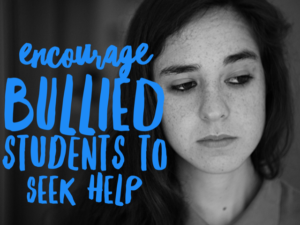
Supporting students who are bullied
March 14, 2018

The National Day Against Bullying and Violence is Friday,16 March. Around Australia, teachers will talk to students about the need to tell a teacher if they or another student is being bullied. This message is clearly captured in most if not all school policies and discussed regularly in classroom bullying prevention programs. Despite this, few students actually report bullying to teachers or other staff members.
A survey of 1,688 Australian students revealed that only 38% of students who were bullied would tell a teacher or school counsellor.[1] Rigby, K. and Johnson, K. (2016), The Prevalence and Effectiveness of Anti-Bullying Strategies employed in Australian Schools, Adelaide, University … Continue reading These students were more likely to tell their friends (53%) or parents (51%).[2]Rigby, K. and Johnson, K. (2016), The Prevalence and Effectiveness of Anti-Bullying Strategies employed in Australian Schools, Adelaide, University … Continue reading The reasons are varied and include:
- fear of repercussions from the bully
- believing the teacher will not take them seriously
- feeling embarrassment or shame
- not wanting to ‘dob’, or get others in trouble and
- believing the issue was not serious enough.
Encourage help-seeking behaviour
To encourage students to report bullying to a staff member, it is important to create an environment where students believe that reporting bullying will make it stop, rather than making things worse, or staying the same. Strategies include:
- Survey or ask students about the helpfulness of the school policies, programs and actions in preventing and addressing bullying.[3] Rigby, K. and Johnson, K. (2016), The Prevalence and Effectiveness of Anti-Bullying Strategies employed in Australian Schools, Adelaide, University … Continue reading Find out what students believe is working to reduce bullying in their school and what could be done better. Act upon appropriate student recommendations and implement evidence-based prevention and intervention strategies. Once changes have been made, asked students to re-evaluate the effectiveness of any programs or strategies that have been put in place.
- Upskill parents. Since students are more likely to report bullying to a parent, schools will benefit from informing parents about what to say and how to respond if their child is being bullied. Provide resources in the newsletter or links to helpful websites on your school website, such as The Bully project, Raising Children and the Victorian Education Department’s Bullystoppers.
- Teach students to be Upstanders. Upstanders help others who are being bullied. If it is safe to do so they speak out and tell the bully to stop or refocus attention away from the person being bullied. If it is not safe for them to intervene they can support the person being bullied afterwards and tell a teacher. Some helpful resources to share with students include:
- 10 ways to be an upstander
- Bystander to upstander – video
- NSW Education Department Anti-bullying Bystander to Upstander activity booklet for teachers and students – lesson plans, worksheets for Years 5-8.
- Bullying. No Way! Active bystander lesson plans – for lower primary to senior secondary level.
For a comprehensive list of recommendations about how to reduce bullying in your school see p.79 of Rigby and Johnson’s (2016) research, The Prevalence and Effectiveness of Anti-Bullying Strategies Employed in Australian Schools, click here.
Or read the Psych4Schools Working with students who are bullied ebooklet.
Zoe Ganim
References